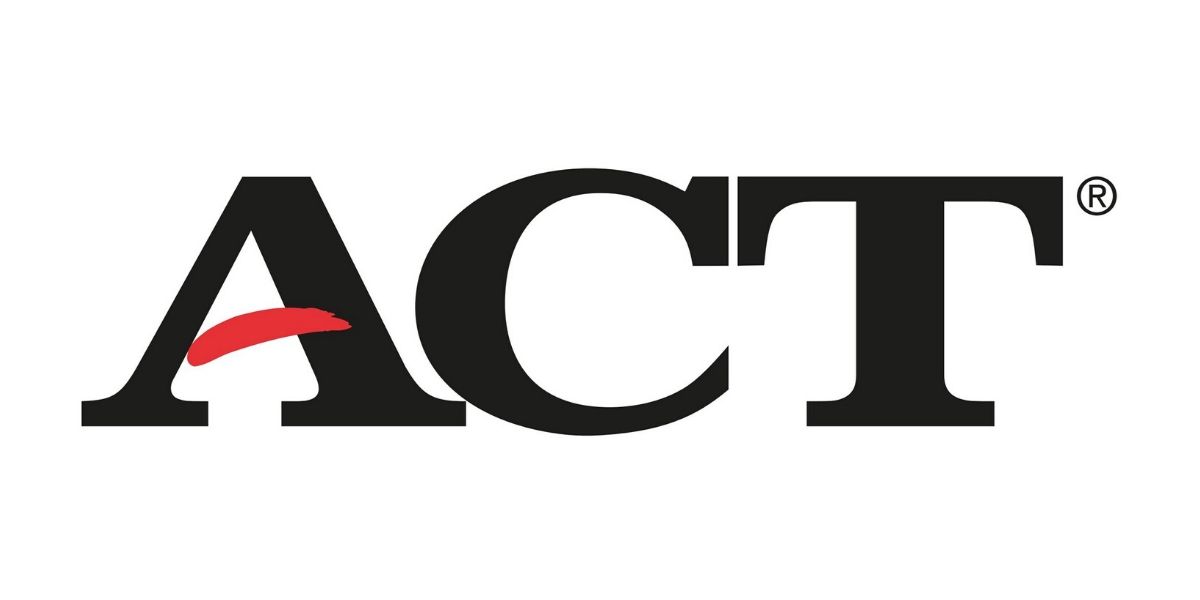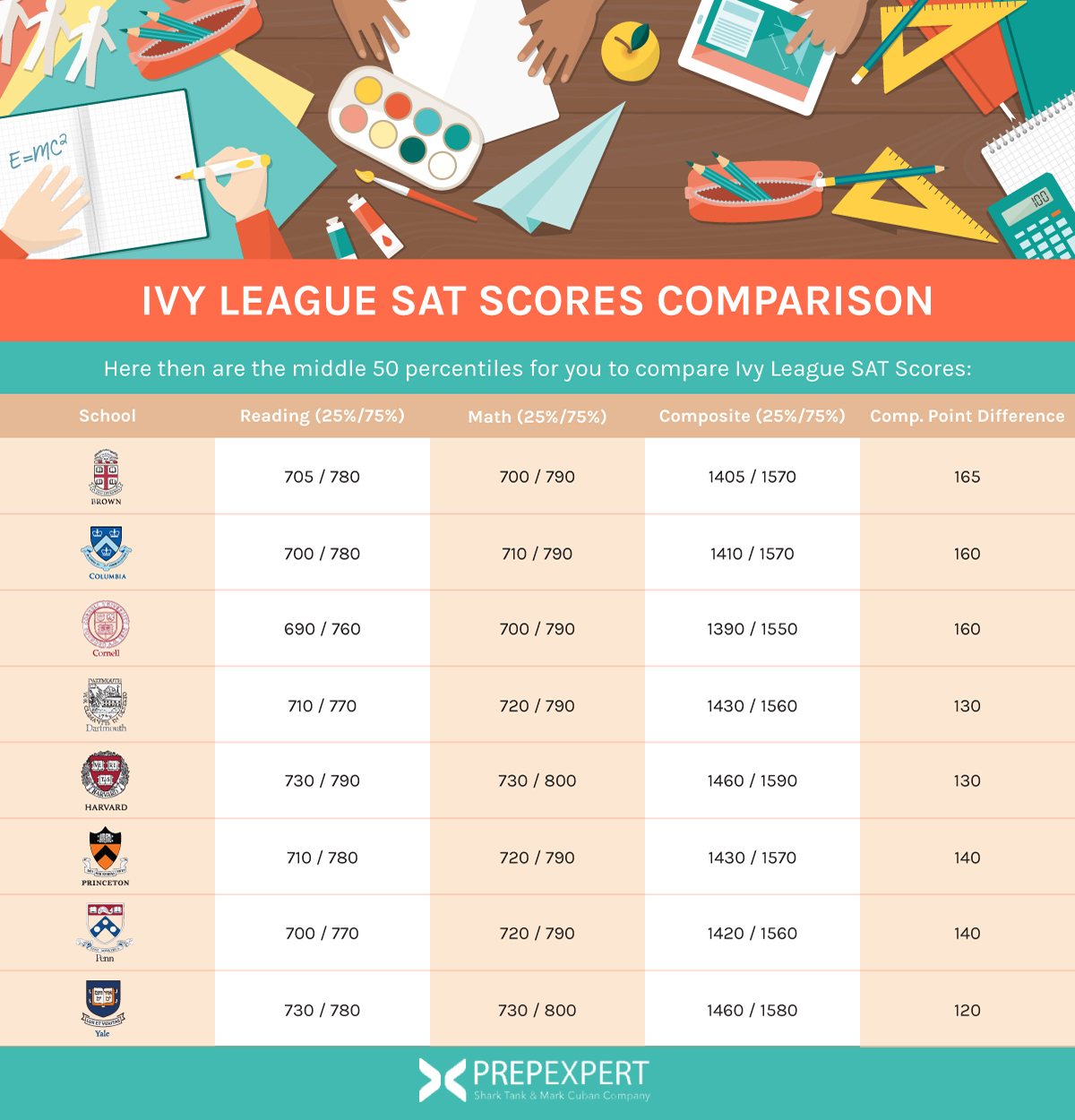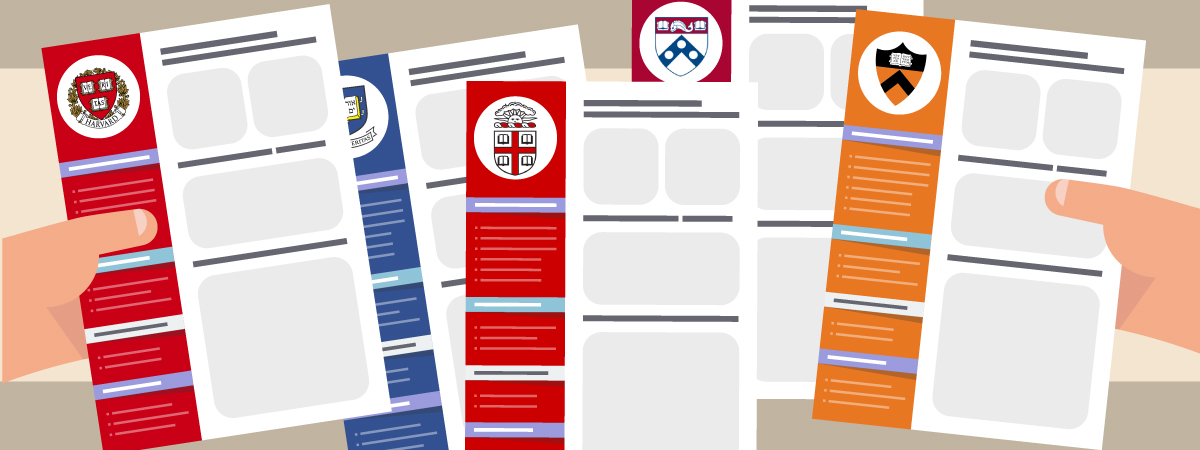Ivy League SAT Scores Comparison
When looking at Ivy League schools and what SAT scores you need to get in, don’t worry; you don’t have to have a perfect score to gain entry.
We are going to break down scores across the Ivy League via the middle 50 percentiles. These scores reflect what students enrolled scored in the bottom 25% of SAT test takers and the top 25% of test-takers in a given year.
For more information and schedules, don’t forget to check out our SAT prep courses today.
[sat_one]
Ivy League SAT Scores Comparison
Here then are the middle 50 percentiles for you to compare Ivy League SAT Scores:
| School | Reading (25%/75%) | Math (25%/75%) | Composite (25%/75%) | Comp. Point Difference |
|---|---|---|---|---|
| Brown University | 705 / 780 | 700 / 790 | 1405 / 1570 | 165 |
| Columbia University | 700 / 780 | 710 / 790 | 1410 / 1570 | 160 |
| Cornell University | 690 / 760 | 700 / 790 | 1390 / 1550 | 160 |
| Dartmouth College | 710 / 770 | 720 / 790 | 1430 / 1560 | 130 |
| Harvard University | 730 / 790 | 730 / 800 | 1460 / 1590 | 130 |
| Princeton University | 710 / 780 | 720 / 790 | 1430 / 1570 | 140 |
| University of Pennsylvania | 700 / 770 | 720 / 790 | 1420 / 1560 | 140 |
| Yale University | 730 / 780 | 730 / 800 | 1460 / 1580 | 120 |
A Few Points To Notice
There are a few simple but noteworthy trends to be aware of when looking at these numbers.
Amongst the list, Brown appears to have to widest range available between the 25th and 75th percentiles at 165 points. What this means for you is more room to score well between those two extremes and increase your chances for admission.
In general though, the wider the range of points between percentiles, the more wiggle room available. This doesn’t mean these schools are any less competitive than each other regarding acceptance rate, that’s an entirely different discussion, which we’ll broach later.
[leadmagnet_five]
The point difference between most schools hovers between 40 or so. At the “easier” end of the scale again you have Brown with a 165 point difference between the 25th and 75th percentile composite scores. Close to half of the Ivy League falls within this point differential.
The next tier (including schools like Harvard and Princeton) tends to hover around 130-140 points. Again, that tightening is noticeable but still leaves you room to improve your score. Perhaps the hardest needle to thread here regarding SAT scores is Yale.
With only 120 points separating the bottom 25% and top 25% of enrolled students’ scores, the margin separating those students who had an easier time getting in versus those with the presumably toughest time is very thin.
What that means for you point-wise is that you should try to shoot for at least 1500 out of 1600 on the SAT. Not an easy task but not impossible either.
[sat_two]
Don’t Forget About Acceptance Rates
Remember though, even if a school boasts high SAT average scores amongst its student body that alone doesn’t signify its competitiveness.
Competitiveness is more accurately illustrated by a given institution’s acceptance rate – the ratio of applicants versus open spots in a given class.
The more students apply for increasingly limited spots per class, the lower a school’s acceptance rate will be. That, in a nutshell, is the biggest variable to examine when assessing a school’s competitiveness.
Many of the schools listed here are among the nation’s most competitive, some with acceptance rates below 10%. However, this list does not comprise every single school with low acceptance rates, so remember, a high SAT composite score does not automatically guarantee admission.
[leadmagnet_two]
For more information on acceptance rates, we have a wide variety of posts available on the blog detailing different college and university acceptance rates. Simply type in a school in the search box followed by ‘acceptance rate’, chances are good we have that information for you.
How Prep Expert Can Help Your SAT Score
Now that we’ve looked at how the SAT breaks down across the Ivy League, let’s discuss how we can help you get one of those scores yourself.
Again, remember that you don’t HAVE to score a perfect 1600 on the SAT to get into an Ivy League school. All you need to do is see how high of a score you need for a particular school and make that your target. That’s it.
Our proven strategies, taught by 99th percentile-scoring instructors, have helped students both get into the schools of their dreams and secure lucrative scholarships. The best part? We provide assistance year-round and always stay up-to-date with the latest test updates.
If you would like to learn more today, then be sure to check out one of our upcoming classes now or contact us by phone or email to get the answers you need.
[sat_three]
For more test strategy, college admissions, and scholarship application tips sign up for our FREE class happening right now!
Ivy League SAT Scores FAQ
Do I need to get a perfect SAT score?
When looking at Ivy League schools and what SAT scores you need to get in, don’t worry; you don’t have to have a perfect score to gain entry. But it’s going to need to be strong.
Which Ivy League has the most room when it comes to considering score range?
Brown appears to have to widest range available between the 25th and 75th percentiles at 165 points. What this means for you is more room to score well between those two extremes and increase your chances for admission.
What’s one of the hardest Ivy League schools to get into regarding SAT scores?
Perhaps the hardest needle to thread here regarding SAT scores is Yale. With only 120 points separating the bottom 25% and top 25% of enrolled students’ score, the margin separating those students who had an easier time getting in versus those with the presumably toughest time is very thin.
Does high SAT score average rate equate with competitiveness?
Competitiveness is more accurately illustrated by a given institution’s acceptance rate, meaning the ratio of applicants versus open spots in a given class. The more students apply for increasingly limited spots per class, the lower a school’s acceptance rate will be.
Written by Todd Marcus
More from Todd Marcus

Taking The ACT Junior Year
If you're ambitious and want to give yourself plenty of time for score improvement, then consider taking the ACT junior…

ACT 2020 Score Release Dates
Here then are the ACT 2020 score release dates to plan around, as well as, the different kinds of available…

How To Determine Your Average SAT Study Time
If you want a high score on the SAT, then you need to put in the hours. There's no way…



